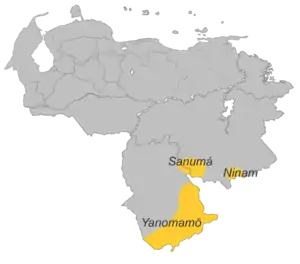Sanumá language
Sanumá /ˈsænʊmə/[3] is a Yanomaman language spoken in Venezuela and Brazil. It is also known as Sanema, Sanima, Tsanuma, Guaika, Samatari, Samatali, Xamatari and Chirichano. Most of its speakers in Venezuela also speak Ye'kuana, also known as Maquiritare, the language of the Ye'kuana people the Sanumá live alongside in the Caura River basin.
| Sanumá | |
|---|---|
| Kohoroxitari | |
| Sanɨma | |
| Pronunciation | [ˈsɑnɨmɑ] |
| Native to | Venezuela, Brazil |
| Ethnicity | Sanumá |
Native speakers | 5,100 (2000–2006)[1] |
Yanomaman
| |
| Language codes | |
| ISO 639-3 | xsu |
| Glottolog | sanu1240 |
| ELP | Sanumá[2] |
 Distribution in Venezuela | |
Sanumá is an isolating language.
Dialects
Some linguists identify dialects such as Yanoma, Cobari, Caura, and Ervato-Ventuari in Venezuela and Auaris in Brazil. All the dialects are mutually intelligible. In Venezuela, Sanumá is spoken in the vicinity of the Caura and Ervato-Ventuari Rivers in Venezuela, while in Brazil, it is spoken in the Auari River region of Roraima.
References
- Sanumá at Ethnologue (18th ed., 2015)
- Endangered Languages Project data for Sanumá.
- Laurie Bauer, 2007, The Linguistics Student’s Handbook, Edinburgh
- Ferreira, Helder Perri; Machado, Ana Maria Antunes; Senra, Estevão Benfica. 2019. As línguas Yanomami no Brasil: diversidade e vitalidade. São Paulo: Instituto Socioambiental (ISA) and Instituto do Patrimônio Histórico e Artístico Nacional (IPHAN). 216pp. ISBN 978-85-8226-076-0
Further reading
- Alcida Ramos, Sanuma Memories: Yanomami Ethnography in Times of Crisis (University of Wisconsin Press, 1995)
- Bruce Parry, Tribe: Adventures in a Changing World (Michael Joseph Ltd, 2007)
This article is issued from Wikipedia. The text is licensed under Creative Commons - Attribution - Sharealike. Additional terms may apply for the media files.